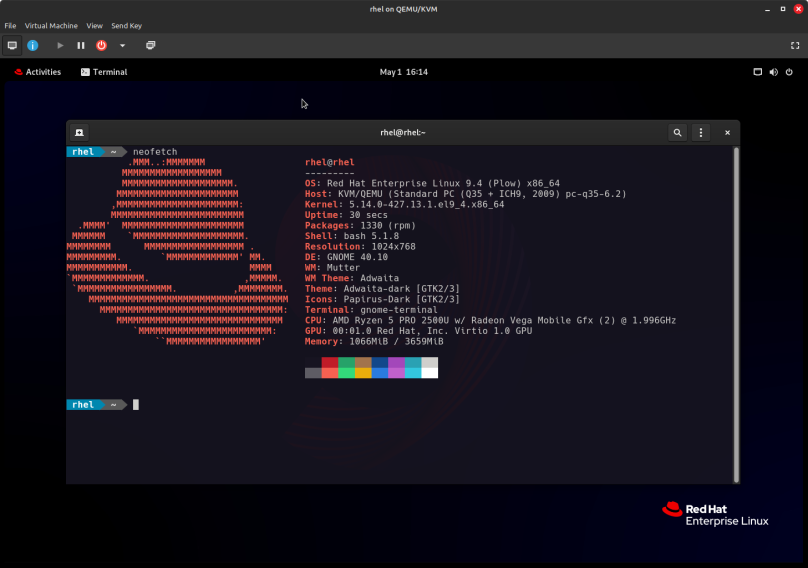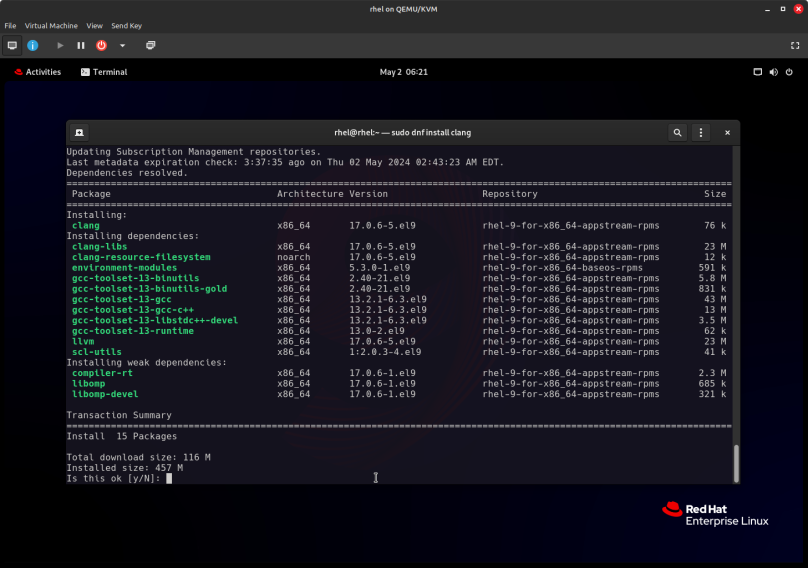
While the majority of the stories about newly released Linux distributions have centered around Fedora 40 and Ubuntu 24.04, Red Hat released Enterprise Linux (RHEL) 9.4 on May 1st. As a RHEL developer I keep a VM running the latest release so I can stay familiar with RHEL in general as well as the tools that come bundled with RHEL. There’s a link at the bottom to the complete what’s new about RHEL 9.4, so I won’t go into breathless detail when you can get the straight scoop from Red Hat. But I am going to comment on some of the tools and the versions they released.
Tools In General
Python 3.12, Ruby 3.3, and PostgreSQL 16 are all great versions; that’s what their current major release levels are. Unfortunately when I updated my RHEL 9.3 instance to RHEL 9.4, I didn’t pick up the latest advertised tools. Instead I’m still at Python 3.9, Ruby 3.0, and PostgreSQL 13.
Other tools advertised with this release were Rust 1.75, Go 1.21, and LLVM 17. The current releases of those tools are Rust 1.78, Go 1.22.2, and LLVM 18. I should point out that Rust 1.78 now requires LLVM 18 as its back-end machine assembler. I should also point out that if you’re contemplating writing Rust drivers for the Linux kernel, 6.8 and later, that you’ll need Rust 1.77 at a minimum as well as a distribution that is running Linux kernel 6.8 or later. Unfortunately RHEL 9.x isn’t one of those distributions as it’s running a version 5 Linux kernel.
I suppose that if I were to perform a clean install of RHEL 9.4 I might actually get the updated tools, but performing an update to RHEL 9.4 from an earlier release, such as I did from 9.3, won’t get you there.
Clang

Clang, the C/C++ language front end for LLVM, isn’t installed by default, but you can install it after installing RHEL. In this instance it’s one major release behind current Clang, which is version 18. If I were to choose between GCC and Clang I believe I’d choose Clang, if for no other reason than GCC is relatively old compared with Clang, and Clang 17 has solid C++ 17 compliance, as well as C++ 20 and C++ 23.
Final Thoughts
RHEL is an IBM company, and it’s beginning to really “smell” like an IBM company that is catering to Big Businesses that use Linux in their businesses. If you work for such a company then RHEL will suit you just fine. If you’re into being more up-to-date with tooling and the latest Linux infrastructure such as the kernel, or if you’re doing kernel development, then I would recommend you use the latest Fedora, Linux Mint, or Ubuntu distributions. I personally use Linux Mint 21.3 with the Linux kernel 6.5 as my daily driver, Ubuntu 23.10 on my Raspberry Pi 5 and Fedora 40 (the latest) on my 2010 Samsung notebook. I’d like to point out that a fourteen year old computer is running one of the latest Linux distributions; with Linux there never truly is an obsolete (Apple calls them “legacy”) computer.
Links
What’s new in Red Hat Enterprise Linux 9.4? — https://developers.redhat.com/articles/2024/05/01/whats-new-red-hat-enterprise-linux-94#
Why I Maintain A RHEL 9.x VM
In the past I have been called upon to work in a RHEL environment, going all the way back to RHEL 5. It therefore behooves me to keep an up-to-date installation so I can remain familiar with the product. As a retired engineer and a consultant, I maintain that I will only work on the latest RHEL release; at this point in time that is RHEL 9, which was initially released in May 2022. Before then it was RHEL 8. Since it’s now a solid two years since RHEL 9’s initial release I believe there’s no excuse not to be running your business on RHEL 9. There are all sorts of excuses why a business refuses to update, but in the end none of them are good. I have turned down work because of the older RHEL releases someone may be using. It’s just not worth the aggravation; no amount of money will make me change my mind.

You must be logged in to post a comment.